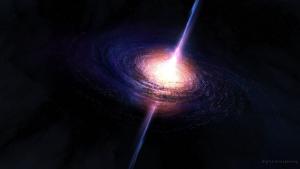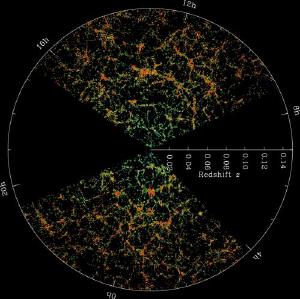Blog
The Chicken or the Egg
20 April 2015
 DigitalBlasphemy
DigitalBlasphemyWhen we observe galaxies across the universe, we find that most of them have supermassive black holes in their centers. Our own Milky Way galaxy, for example, has a black hole of about 4 million solar masses. This connection between black holes and galaxies raises an interesting question regarding the origin and evolution of galaxies. Did early galaxies form around black holes, or did black holes form within young galaxies? In other words, which came first, the black holes or the galaxies?
There are two basic models for the origin of galaxies. In the top down model, supercluster-sized clouds of gas collapse upon themselves. These clouds then fragment into galaxy-sized clouds that continue to collapse into full-fledged galaxies. The stars and dust within the centers of these galaxies eventually collapse into black holes that grow to supermassive size over time. This model is similar to the way stars form within stellar nurseries, where lots of stars are born from a single large cloud. The alternative is the bottom up model. In this approach small pockets of gas collapse first, which then merge to form galaxies. These galaxies then form into clusters and superclusters later on. In this model stars and black holes would tend to form before galaxies.
 SDSS
SDSSBoth models have some observational evidence to support them. When we look at the distribution of galaxies across the universe, for example, we find that they are grouped into clusters and superclusters at all scales. This is what you would expect if the early universe had the initial supercluster-sized clouds of the top down model. But we also see early fluctuations on a small scale. In particular, the effects of cold dark matter come into play early on, so star formation (and likewise the formation of black holes) began early on as well. This is further supported by the fact that within 400 – 500 million years after the big bang the first stars were already shining. So basically it looks like both the top down and bottom up processes contributed to the to the process. Galaxies formed through a process of mergers, but those protogalaxies were already part of a large supercluster structure.
But while both processes seem to play a role, the bottom up process has an advantage. That’s because gravitational interactions between masses don’t occur instantly. Gravitational disruptions travel the universe at the speed of light, so interactions on a small scale have a leg up. That means stars and black holes likely formed first, and large black holes were at the centers of early protogalaxies. Through mergers these black holes grew to the supermassive ones we see today.